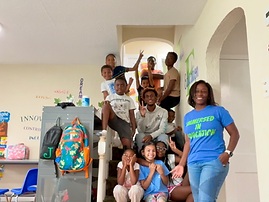Unlocking the Future Young Engineers Thrive with Summer STEAM Tutoring
- Immersed In Education

- Jul 3
- 4 min read
In today’s fast-paced world, nurturing a love for engineering and technology in young minds is crucial. This is where STEAM (Science, Technology, Engineering, Arts, and Mathematics) summer tutoring comes into play. This innovative approach combines traditional learning with creativity, inspiring young engineers to explore, create, and excel.
Imagine your child as a future scientist, inventor, or tech-savvy artist; summer tutoring can significantly shape their journey and help them unlock their full potential.
The Importance of STEAM Education
STEAM education offers a well-rounded approach that goes far beyond memorizing facts from textbooks. By merging the arts with STEM disciplines, students gain a versatile perspective and the creativity needed to tackle complex challenges.
Consider this: by 2030, 85 million jobs may go unfilled due to a lack of qualified individuals in the STEAM fields. Fostering innovative thinkers today prepares them to meet this demand. Introducing young minds to STEAM during the summer encourages confidence and equips them to handle future obstacles.
Why Summer Tutoring?
The summer break provides an excellent opportunity for students to dive into subjects that spark their interest without the stress of grades. Here are key reasons why STEAM summer tutoring can be especially advantageous:
1. Personalized Learning Experience
During the school year, large class sizes can make it hard for teachers to give each student individual attention. Summer tutoring creates a tailored experience, focusing on each learner’s interests, strengths, and areas needing improvement. For instance, a child interested in coding could spend time building a simple game, allowing them to learn at their own rhythm.
2. Hands-On Learning
Young engineers thrive on experimentation. Summer tutoring offers hands-on projects—like building a robot or designing a simple app. Engaging in such activities not only deepens understanding but also cultivates crucial skills like resilience and problem-solving. Research shows that students involved in hands-on learning retain information better, with a reported increase in retention rates of 25% to 60%.
3. Encouragement of Curiosity and Creativity
A summer STEAM program can foster an environment where students feel free to ask questions and explore diverse creative pathways. For example, combining art and engineering through a project like designing a sustainable garden using recycled materials can enhance both analytical and creative skills. By blending disciplines, students develop innovative thinking vital for success in today’s world.

4. Building a Community of Learners
Summer tutoring creates a supportive community of students sharing similar interests. Participating in group projects fosters teamwork and communication—skills essential for any young engineer. Through collaboration, children exchange ideas, enriching their learning experience and making friendships along the way.
Key Components of Effective Summer STEAM Tutoring
To maximize the benefits of summer STEAM tutoring, certain elements should be vital in the program:
1. Relevant Projects
Choose projects that address real-world challenges. For instance, students could investigate solutions for waste reduction, creating functional art that raises awareness about environmental issues. Such relevance boosts engagement and allows learners to see the impact of their education.
2. Diverse Learning Materials
Using a wide range of materials—like books, online resources, and interactive tools—keeps students inspired and engaged. This variety can lead to deeper understanding and makes the learning process dynamic. For example, a child may explore physics through a science fiction novel and then analyze it through practical experiments.
3. Regular Assessments and Feedback
Although summer tutoring centers on exploration rather than grading, periodic assessments can gauge student progress. Knowing their strengths and areas for improvement allows tutors to adjust sessions accordingly, enhancing the learning experience.
4. Integration of Technology
As technology is central to engineering, it should be incorporated into the learning process. Students can use coding platforms, simulation software, or even virtual field trips to engineering centers. Familiarity with these tools benefits them in future careers, with 75% of jobs in the next decade requiring some technological skill.
Inspiring Young Engineers to Pursue Their Interests
Parents and guardians play a crucial role in encouraging a passion for STEAM education. Here are some practical tips to help guide your child's engineering interests during the summer:
1. Encourage Exploration
Give your child the freedom to explore different STEAM subjects. Whether it’s robotics, coding, or chemistry, provide access to resources that captivate their interest. This will help them uncover their passions and develop management of their projects.
2. Foster a Growth Mindset
Support your child in viewing challenges as chances to learn. Celebrate every success, however small, and reaffirm that persistence is key to mastering new skills. Research indicates that students with a growth mindset are 34% more likely to achieve higher grades.
3. Create a STEAM-Friendly Environment
Set up a specific area where your child can work on projects, conduct experiments, or freely explore materials. This comfortable space, filled with educational resources, sparks creativity and enthusiasm for learning.
4. Engage with Professionals
Connect your child with local engineers or STEAM professionals through camps or workshops. Seeing real-life applications of their interests can ignite passion and energize their pursuits.
Shaping the Innovators of Tomorrow
Engaging in summer STEAM tutoring opens valuable opportunities for young engineers to create, discover, and innovate. By emphasizing individualized learning, hands-on experiences, and real-world applications, we prepare the next generation to tackle the challenges ahead.
Encouraging a balance of creativity and analytical skills lays the foundation for the problem-solvers of tomorrow. Let this summer be a transformative season—where curiosity meets opportunity and learning extends beyond the classroom.









Comments